
Options trading, the word option adorns a different meaning. Option in stock market terms means contract. Options trading contract bestows a trader with the right to buy/sell the underlying assets at a destined price and time. Every option has its own expiration time. Time plays a crucial role in profit generation via options trading.
The strategies of trading adopted are the second most important factor in the row. This article throws light on the nooks and corners of options trading. A call option gives the buyer the right, but not the obligation, to buy a stock at a predetermined price within a certain time period.
A put option gives the buyer the right, but not the obligation, to sell a stock at a predetermined price within a certain time period. When trading options, it is important to determine the correct strike price and expiration date. The strike price is the price at which the underlying stock can be bought or sold,
What is the meaning of Options Trading?
Options trading is an investment strategy where individuals have the right to buy or sell a specific underlying asset at a predetermined price and within a specified period. Options trading is complex and risky and requires a solid understanding of the market and the underlying asset traded.
The underlying asset can be a stock, currency, commodity, or index. Option trading helps the investor/trader to buy /sell stocks. The return received by the seller from a buyer for the option granted is called a premium. A buyer pays a premium when they buy an option. The buyer receives a premium on selling an option.
What are the Options?
Option is a financial instrument that gives the investor the right, but not the obligation, to buy or sell a specific underlying asset at a specified price within a period. Option buyers get charged an amount called the premium. The options include long-term options and short-term options depending on the expiry time.
There are two types of options: call options and put options. A call option gives the holder the right to buy, while a put option gives the holder the right to sell. Options can be used in a variety of ways by investors and traders.
How does Options Trading function?
Let’s consider the following scenario to understand how options trading works:
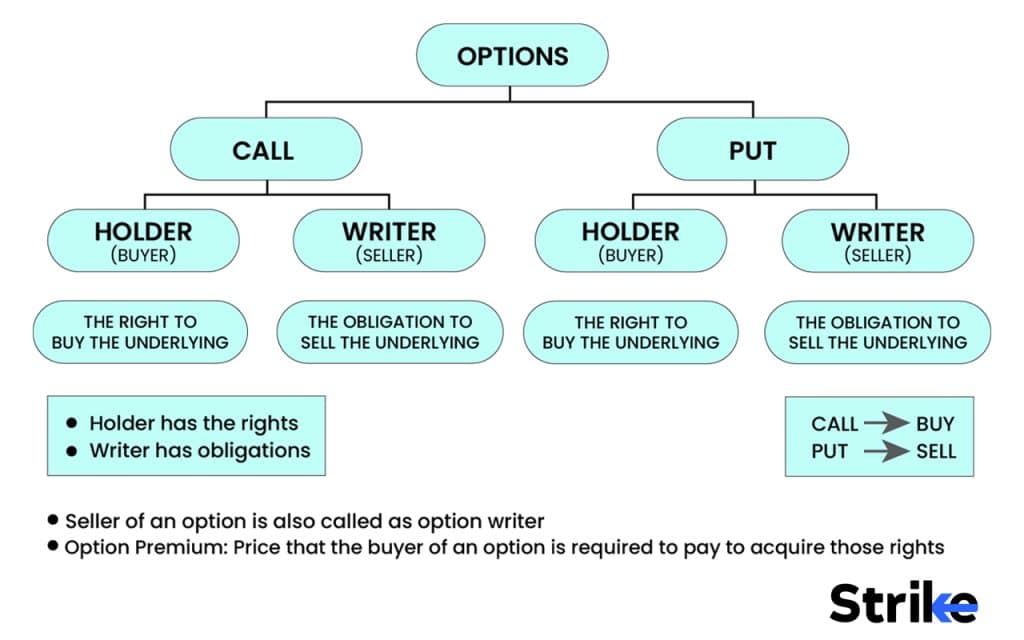
Suppose an investor believes that the stock price of company XYZ is going to increase in the next few weeks, and they decide to purchase a call option contract for 100 shares of XYZ at a strike price of $50 per share with an expiration date of 60 days. The premium for the option is $5 per share, so the investor pays $500 ($5 x 100 shares) for the option contract.
The investor can exercise the option and buy 100 shares of XYZ at the strike price of $50 per share, if the stock price of XYZ does increase as the investor predicted. It can also happen when the strike price rises to $60 per share before the expiration date. This means that the investor has the right to buy the shares for $50 and then sell them for $60 in the market, making a profit of $10 per share, or $1,000 for the 100 shares.
However, the investor may choose not to exercise the option, and the option will expire worthless, if the stock price of XYZ does not increase as the investor predicted and stays below the strike price of $50. The investor will lose the premium of $500 they paid for the option.
Investors can also sell options to other traders or investors. An investor could sell a call option contract on XYZ with a strike price of $60 and an expiration date of 60 days for a premium of $3 per share. The investor keeps the premium they received for selling the option if the stock price of XYZ does not rise above $60 by the expiration date. However, The investor will be obligated to sell the shares at the strike price of $60 if the stock price does rise above $60.
Options trading provides traders and investors with flexibility and the ability to hedge against risks or speculate on market movements. However, it is important to remember that options trading can be complex and risky, and requires a good understanding of the market and associated risks.
How to Trade Options?
Trading options involve seven basic steps that a trader needs to follow. Here’s a general outline of how to trade options:
- Learn the basics: It’s essential to understand the fundamentals of options trading because options trading is a risky process.
- Choose a broker: Select a broker that offers options trading services.
- Open an account: After selecting a broker, traders need to open an options trading account.
- Strategy development: Traders need to decide on a strategy aligning with the trader’s financial goals and risk tolerance.
- Place an order
- Trade monitoring: After placing the order, traders need to monitor the trade’s progress.
- Risk management: Options trading involves risk, and traders need to manage their risks by setting stop-loss orders or buying protective puts to limit potential losses.
Options trading are made easier and user friendly by following the above mentioned steps. Make sure to start from the basics and understand option trading to ensure you are capable of making the right moves.
How to Buy/Sell Options?
The buy/sell option can be simply demonstrated through four steps. This includes option contract selection, order placing, paying/receiving the premium, and trade monitoring. Each step helps in making the process of buying and selling easy and user-friendly.
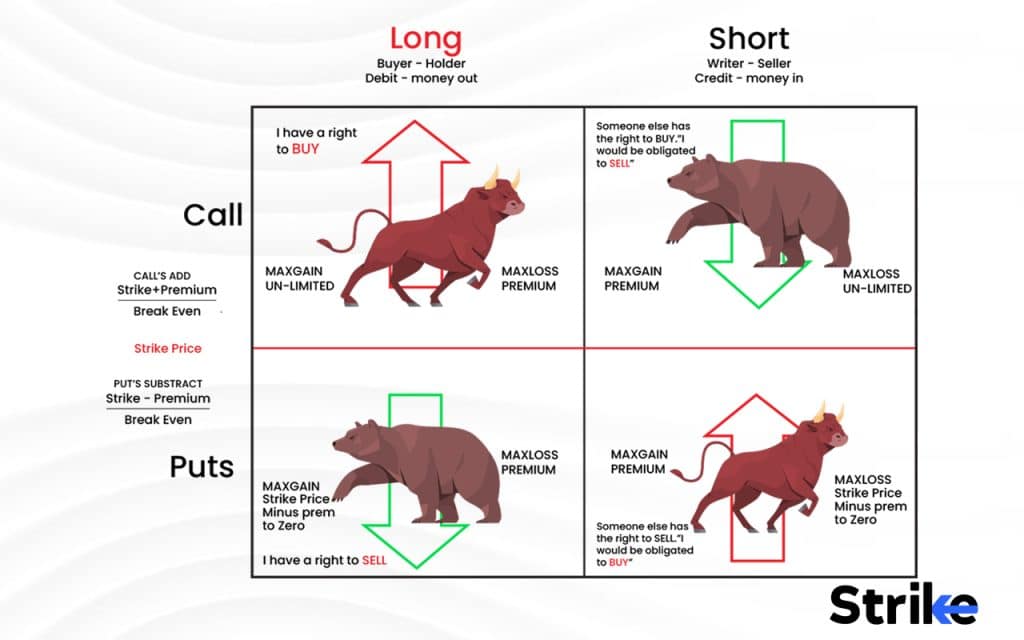
Traders need to follow four simple steps to buy an option:
- Choosing options contract: Traders must select an options contract that aligns with their investment strategy. Option selection depends on the factors like the expiration date and the strike price.
- Placing an order: The traders place their order through their broker’s trading platform.
- Pay the premium: Traders pay a premium to the options seller to buy an option. It varies depending on factors such as the underlying asset’s price, volatility, and expiration date.
- Trade Monitoring: Traders need to monitor the trade’s progress and decide whether to hold the option or sell it before expiration after buying.
Traders need to follow four steps to sell options:
- Select an options contract: Traders need to select an options contract they want to sell and determine the strike price, expiration date, and the premium they want to receive.
- Order placing: Traders place their order to sell an options contract through their broker’s trading platform.
- Receive the premium: The trader receives the premium from the buyer after selling.
- Monitor the trade: Traders monitor the trade and manage their risks to limit potential losses.
Traders must develop their risk management strategy and stay focussed on market trends to achieve their financial goals. The rapid change in the market trends may affect the buying and selling of the options. The sudden market change may also affect the income generated.
When to Buy and Sell Options?
The sell/buy decision solely depends on the investment strategy and the market conditions. Here are five general guidelines:
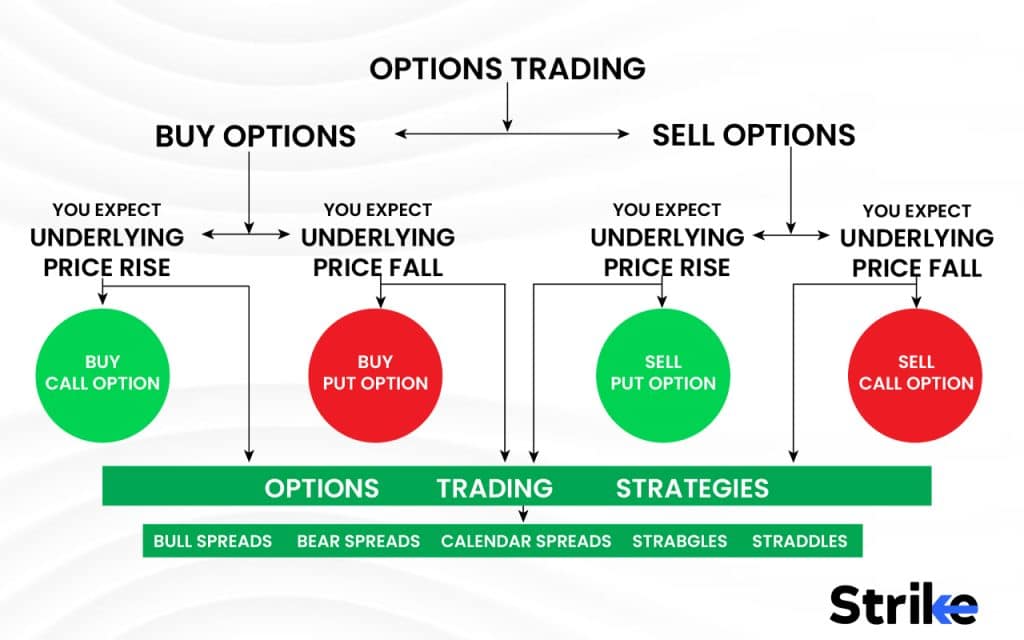
- Buy options when the underlying asset price moves in your favor.
- Sell options when the underlying asset price remains relatively stable.
- Keep a check on the expiration time, i.e., consider the time decay factor.
- Monitor market volatility. Market volatility affects the Options prices. Buying options becomes a good strategy when the volatility is high. The selling option is the best strategy in case of low volatility.
- Analyze the market trend. Buying call options is a good strategy, if the market is bullish. Buying put options is a good strategy, if the market is bearish.
Why Trade Options?
The key benefits of choosing the trade option include the following six:
- Flexibility: Traders can customize their trades to suit their financial goals, risk tolerance, and market outlook. Options traders can choose a variety of strategies, including buying or selling options, hedging, and using spreads.
- Limited risk: Options trading allows traders to limit or manage their risks and control their losses.
- Diversification: Options trading allows traders to diversify their portfolios.
- Potential for high returns: Options trading provides traders with the potential for high returns as they can profit from small price movements in the underlying asset.
- Liquidity: Options trading helps traders to buy and sell options contracts quickly and easily.
- Hedging: Traders can use hedging options to limit their downside risk and protect their portfolios from losses.
Options trading provides traders with flexibility, limited risk, the potential for high returns, diversification, hedging, and liquidity. Traders can use options to achieve their financial goals, manage risk exposure, and protect their portfolios from market volatility.
How to Use Technical Analysis in Options Trading?
Technical analysis is a popular tool for identifying potential trading opportunities and studying market trends. Here are four ways to use technical analysis in options trading:
- Identify trends: Traders can use trend lines, moving averages, and other technical indicators to understand the trend direction, for identifying the trend.
- Determine support and resistance levels: Technical analysis can help traders determine support and resistance levels to identify potential entry and exit points for their options trades.
- Use chart patterns: Chart patterns can help traders identify potential trend reversals or continuation patterns.
- Use technical indicators: Technical indicators such as Relative Strength Index (RSI), Moving Average Convergence Divergence (MACD), and Bollinger Bands can help traders determine whether the underlying asset is overbought or oversold and whether a trend reversal is likely.
Technical analysis, in conjunction with fundamental analysis, develops a sound trading strategy to achieve financial goals.
What are the Best Options Trading Platforms?
The best options trading platform will depend on individual needs and preferences. There are many options trading platforms with different features available. Here are five of the best options trading platforms currently available:
- TD Ameritrade: This platform offers a robust set of options trading tools and resources, including customizable options chains, strategy testing tools, and a virtual trading simulator. The pros of this platform include a broad range of product offerings, excellent educational materials, and solid options analytics on thinkorswim®.
- ETRADE: ETRADE offers advanced options trading tools, including customizable options chains and options trading strategies.
- Charles Schwab: This platform offers options trading tools such as advanced charting, options chains, and trading calculators. It also offers a variety of educational resources and a virtual trading simulator.
- Interactive Brokers: Interactive Brokers is a popular options trading platform that offers low trading fees, advanced trading tools, and a wide range of investment products.
- Robinhood: Robinhood is a commission-free trading platform that offers options trading, as well as other investment products such as stocks and cryptocurrencies.
It is not possible to select one trading option as the best. The selection of the trading option depends on the trader’s investment strategy and the risk management plans undertaken. The trader’s outlook on the market helps in selecting the best method among the above-mentioned ones.
What are Options Trading requirements?
Options trading requirements vary depending on the broker and the type of options traded. Options trading requires traders to have a margin account, apply for approval with their broker, understand the options contract specifications, and meet margin requirements. Here are five requirements for options trading:
Traders must have a margin account to trade options. Margin accounts require traders to deposit a minimum amount of cash or securities as collateral. The minimum deposit required to open a margin account varies by broker. Options trading typically requires traders to apply for approval with their broker. Traders are required to provide information about their trading experience, financial situation, and investment objectives.
Brokers assign traders different options trading levels based on their experience and financial situation. Higher levels require higher minimum balances, more trading experience, and more advanced trading strategies. Margin requirements vary depending on the underlying asset, the options contract, and the broker’s policies. Margin requirements change based on market conditions, volatility, and other factors. Traders should read and understand the risks before trading options.
The basic requirements for making options trading smoother includes the experience in assigning the trading levels, and the ability to manage risk. The proper usage of technical analysis tools in conjunction with this helps in the efficient output from the option trading market.
Can you Trade Options in the Stock Market?
Yes, options trading is a common practice in the stock market. Options are contracts that authorize the trader to buy or sell a particular stock at a specific price and time in the stock market. Options trading can be used for various purposes, such as hedging against potential losses, generating income, or speculating on price movements. It can also be risky and requires thorough knowledge of market trends, options pricing, and trading strategies.
What are the types of Options Trading?
A put option and a call option are both types of financial contracts that give the holder the right, but not the obligation, to buy (call option) or sell (put option) an underlying asset at a strike price within a certain period.
The main difference is the direction of the underlying asset’s movement. A call option gives the holder the right to buy the underlying asset at the strike price if they believe the asset price will rise above the strike price. It is a bullish strategy because the option holder wants the underlying asset price to increase. A put option gives the holder the right to sell the underlying asset at the strike price if they believe the asset price will fall below the strike price. It is a bearish strategy because the option holder wants the underlying asset price to decrease.
1. Call Options
A call option is a type of options contract that gives the buyer the right to buy an underlying asset, such as a stock, at a strike price on or before a specific expiration date. Call options trading involves buying or selling call options contracts. It is a bullish strategy.
2. Put Options
A put option is another type of options contract that gives the buyer the right, but not the obligation, to sell an underlying asset, such as a stock, at a strike price on or before a specific expiration date. Put option trading involves buying or selling put options contracts. It is a bearish strategy.
The two types of options trading mentioned above are applicable in different scenarios and in the case of different types of options. The selection of the option trading types depends on the market . It is different for the bearish and bullish markets.
What are the Categorization of Options
Options are categorized based on their expiration time into two. It includes the long-term options with a longer expiration time and the short-term options which have a shorter expiration time.
1. Long-Term Options
Long-term options are contracts with a longer expiration date, typically one year or more. Long-term options are also known as Long-Term Equity Anticipation Securities ( LEAPS ). These options provide the opportunity to speculate on the long-term performance of an underlying asset, such as a stock, index, or commodity, with reduced short-term risks. It also ensures greater flexibility. The long-term options are expensive due to the additional time value. LEAPS are less liquid, and their prices are sensitive to market changes.
2. Short-Term Options
Short-term options are options contracts with a shorter expiration date than standard options contracts, typically lasting a few days, weeks, or months. Short-term options allow investors to make quick profits in a relatively short period. Short-term options tend to be more volatile and risky than long-term options because of the shorter time frame, and the prices of these options can be more sensitive to changes in market conditions and the price of the underlying asset. Short-term options are also known as “weekly options,” “monthly options,” or “quarterly options,” depending on their expiration date. These options offer investors more flexibility than the standard options.
Option categorization based on the expiration time frame helps in risk reduction. This also helps in responding quickly to the changing market conditions.
What are the Key Features of Options Trading?
There are seven key features of options trading. It includes intrinsic value, strike price, options premium, contract size, expiration time, settlement of options, etc.
1. Intrinsic Value
Intrinsic value is a financial term to describe the actual value of an asset based on its underlying characteristics and not its market price. Intrinsic value is the difference between the current price of the underlying asset and the strike price of the option.
The intrinsic value is the difference between the current and strike price for call options. The option has intrinsic value if the underlying asset possesses a higher current price than the strike price. The intrinsic value is the difference between the option’s strike price and the underlying asset’s current price for put options. The option has intrinsic value if the underlying asset’s current price is lower than the strike price. The intrinsic value of an option represents the “real” value. Options traders use intrinsic value as a key factor in determining whether to exercise an option or let it expire.
2. Strike Price
A strike price is a price at which the owner of an option can buy/sell the underlying asset. The strike price is also known as the exercise price or the striking price. The strike price is specified in the options contract and remains constant throughout the life of the option.
For example, let’s say that an investor purchases a call option on shares of ABC company with a strike price of $50 and an expiration date of six months from now. The investor can exercise the option and buy the shares at the strike price of $50 if the price of ABC stock rises to $60 before the expiration date. The investor can then sell the shares in the market for $60 and make a profit.
The strike price determines the potential profit or loss of an option. The further the strike price is from the current market price of the underlying asset, the higher the potential profit (or loss) of the option. The options with higher strike prices also have a higher risk of expiring worthless.
3. Options Premium
The premium is the price the buyer of an option pays to the seller in options trading. It is the cost of the option contract. It is determined by the current market price of the underlying asset, the strike price, the expiration time, and the volatility of the underlying asset. Options with higher premiums have a higher probability of being exercised, as they offer greater potential profits to the buyer. The premium is an important factor in options trading, as it represents the potential profit or loss that can be made from the option contract. It is important to consider the premium, along with other factors, when deciding whether to buy or sell an option.
For example, the investor would need to pay $500 (100 shares x $5 premium) to buy the option contract, if an investor wants to purchase a call option on shares of ABC company with a strike price of $50 and an expiration date of six months from now, and the option premium is $5. The investor can exercise the option and buy the shares at the strike price of $50, if the price of ABC stock rises above $55 before the expiration date. The investor can then sell the shares in the market for a profit.
4. Contract Size
The contract size refers to the deliverable quantity of stocks here, the underlying asset. The contract size determines the amount of the underlying asset controlled by the options contract controls. It is also a factor in determining the premium of the option. It is important to understand the contract size before trading to avoid surprises and risks.
5. Expiration Date
The expiration date is the date on which an options contract expires and becomes invalid. The option cannot be exercised, it becomes worthless after expiration. The expiration date is specified in the options contract and varies depending on the exchange and the underlying asset. For example, some options contracts expire in a few weeks, while others have expiration dates that are several months or even years away.
It is important to pay attention to the expiration date when trading options, as it determines the amount of time the investor has to exercise the option and realize any potential profits.
6. Settlement of an Option
Settlement of an option refers to the process by which the buyer and seller of an option fulfill their contractual obligations. There are two main methods of settlement depending on the type of option and the exchange-traded: physical settlement and cash settlement.
Physical settlement: The buyer of a call option has the right to purchase the underlying asset at the strike price, while the seller of the call option is obligated to sell the underlying asset at the strike price.
Cash settlement: The buyer and seller agree to settle the option’s value in cash rather than exchanging the underlying asset.
The amount is determined based on the difference between the strike price and the current market price of the underlying asset at the time of expiration.
7. No obligation to Buy or Sell
The seller of the option is obligated to sell or buy the underlying asset if the buyer chooses to exercise the option.
Traders have the right to buy the underlying stock at a specified price (the strike price) before the expiration date if an investor purchases a call option on a stock. The investor can exercise the option and buy the stock at the strike price if the stock price rises above the strike price. However,The investor is not obligated to buy the stock and can simply let the option expire, if the stock price does not rise above the strike price.
Similarly, the traders are obligated to buy the underlying stock at the strike price if the buyer chooses to exercise the option, if an investor sells a put option on a stock. However, the buyer is not obligated to sell the stock to the investor, and the option will simply expire if the stock price remains above the strike price.
Understanding how each of these components affects options trading is crucial for investors to employ effective strategies, manage risks, and generate profits. Evaluating these parameters allows traders to make informed decisions when buying or selling options based on their market outlook and risk tolerance.
What are Examples of Options Trading?
The below-mentioned five examples of options trading help in understanding the concept much easier. They are as follows:
- Buying a call option: An investor buys a call option on a stock they believe will rise in price. The investor can exercise the option and buy the stock at the strike price, making a profit if the stock price rises above the strike price.
- Trading index options: Index options allow investors to trade on the overall movement of the market rather than on individual stocks.
- Hedging with options: An investor can use options to hedge against potential losses in other investments.
- Selling a put option: An investor sells a put option on a stock they believe will rise or remain stable in price. The investor can keep the premium paid by the buyer of the put option and make a profit if the stock price remains above the strike price.
- Writing a covered call: An investor who owns a stock writes a call option on the stock.
Options trading becomes clear to the traders only by exercising the trade. The above-mentioned examples help in understanding the concept of options trading in a better manner.
What are the advantages of Trade options?
Options trading can offer the following five advantages for investors:
- Risk minimization: It allows investors to limit their potential losses. The maximum amount lost is the premium during an option purchase.
- Flexibility: Options trading offers greater flexibility which makes it popular among traders. Hedging and leverage are examples of the flexibility offered by options trading.
- Leverage: Options trading helps to control a large amount of stock for a fraction of the cost.
- Diversification: Options trading helps in portfolio diversification and gaining exposure to various sectors, industries, and markets.
- Income generation: Options trading can provide investors with a way to generate income.
The generation of maximum profit by understanding the market and the market trends makes options trading important. The insights on risk reduction, leverage, diversification and income generation help in options trading. The proper understanding and the technical tool usage help in avoiding the underlying risks.
What are the disadvantages of Trade options?
Options trading can offer five potential disadvantages that investors should be aware of, especially the limited duration and complexity.
- Limited duration: Options have a limited lifespan. The investor may lose their entire investment if the option expires before the stock price moves in the desired direction.
- Complexity: It requires a thorough understanding of options pricing, strategies, and market conditions.
- Higher risk: It involves higher risks than buying and holding stocks.
- Higher costs: It involves higher trading costs than buying and holding stocks.
- Limited liquidity: Limited liquidity leads to wider bid-ask spreads and lower execution prices. It can impact profitability.
Developing strategies to resolve the above-mentioned disadvantages help in increasing the profit margin. These strategies depend on the individual needs and the market structure.
What are the most successful Options Trading Strategies?
One strategy that is quite popular among experienced options traders is the butterfly spread which allows a trader to enter into a trade with a high probability of profit, high-profit potential, and limited risk. The following three are a few popular options trading strategies that are often used by traders:
Covered Call: This strategy involves selling already-owned call options on an underlying asset.
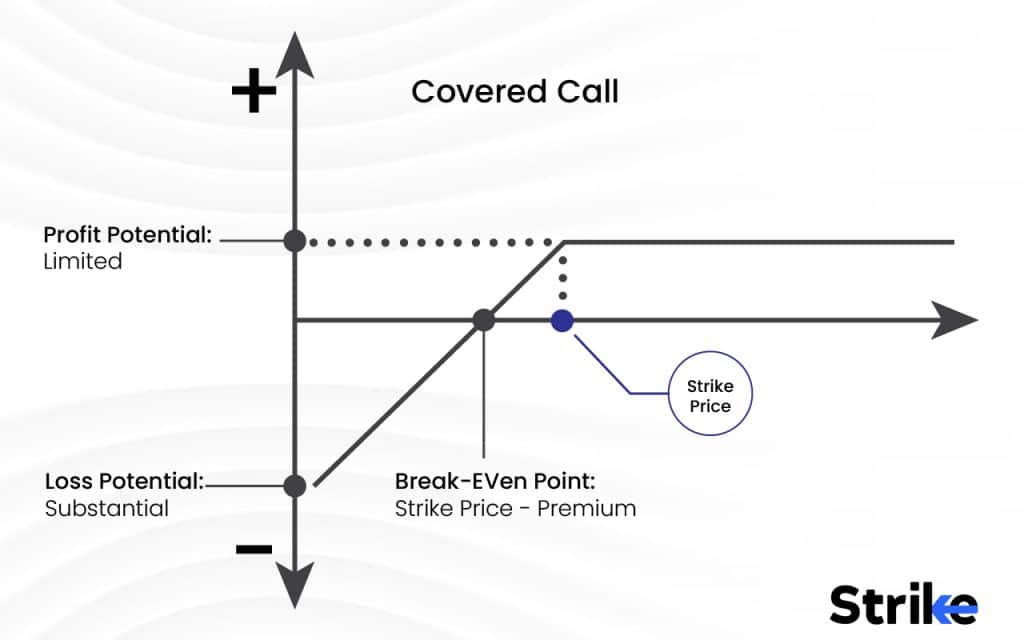
Straddle: A straddle involves buying both a call option and a put option on an underlying asset with the same expiration date and strike price.
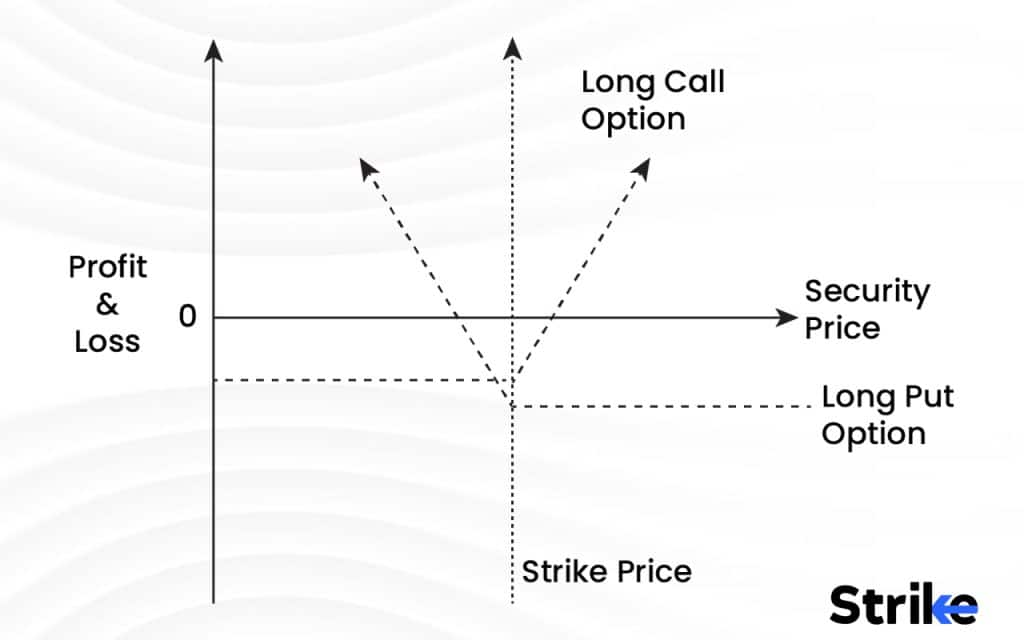
Iron Condor: This strategy involves selling both a call and put option on an underlying asset with different strike prices and buying both a call and put option at a further out-of-the-money strike price. The goal is to profit from the premium received from selling the options while limiting the potential loss.
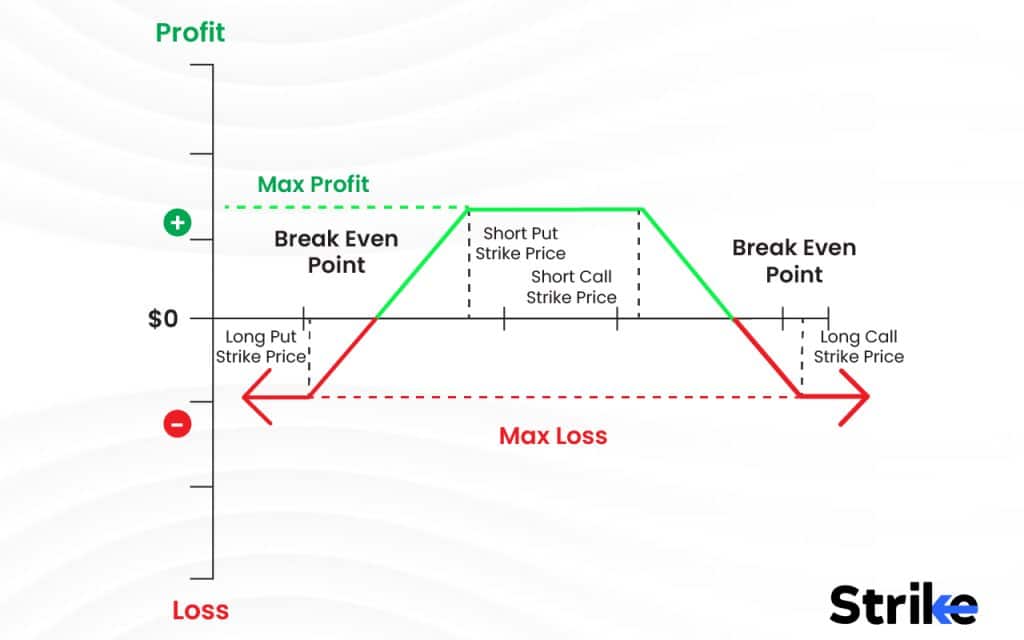
The best options trading strategy depends on individual goals, risk tolerance, and trading style. The choice of strategy solely depends on the trader and his/her profit goals.
Can beginners do Options Trading?
Yes, Beginners can do options trading but requires proper understanding. Options trading is a complex, sophisticated investment strategy, and beginners should be cautious. Some factors to consider before starting options trading include the following four:
- Education: Beginners should have a clear understanding of option trading. This knowledge is obtained by reading books, taking courses, attending webinars, and practicing with virtual trading platforms
- Risk management: Devise a well-developed risk management strategy before initiating option trading. It includes setting stop-loss orders, limiting position sizes, and diversifying their portfolio.
- Brokerage platform: Beginners should choose a user-friendly, reliable brokerage platform.
- Capital: Arrange capital investments to meet the potential losses.
Beginners can do options trading, abiding by the safety policies with a well-defined strategy and solid understanding of options basics, risk management, and market conditions.
Is Options Trading risky?
Yes, options trading is a risky investment strategy. It involves higher risks than buying and holding stocks. Options trading involves higher risks than stock trading because options traders can lose their entire investment if the underlying stock price moves in the opposite direction of their position. Options trading involves higher trading costs than buying and holding stocks. Options trading can also provide investors with various strategies to limit potential losses, hedge against market risks, and generate income. Options trading, therefore, can be an effective investment strategy for experienced investors.
Is it profitable to sell Options?
No, Selling options can be profitable under the right circumstances, but it is necessary to understand the risks involved. The direction of movement of the underlying assets plays a pivotal role in the option selection and expiration.
Selling options carry significant risks. Significant market risk exposure occurs if the seller option is not properly hedged. Experienced investors with a thorough understanding of options pricing, strategies, and market conditions should do the selling option.
Is it better to buy or sell Options?
The decision to buy/sell options depends on the investor’s investment objectives, risk tolerance, and market outlook. The success rate of buying and selling depends on the circumstances. It can be profitable with underlying risks and rewards. Buying options can provide investors with leverage and limited downside risk. The maximum loss is limited to the premium paid. Buying options require more frequent trading activity to maintain the investment position.
Selling options can provide investors with regular income and limited upside risk. The maximum gain is limited to the premium received. Buying options in general, is a more suitable strategy for investors seeking higher returns and willing to accept higher risks. Selling options are more suitable for investors seeking regular income and willing to accept lower returns and limited risks.
Can I sell the Options without buying?
Yes, it is possible to sell options without owning them first. A common strategy used by options traders to generate income or hedge against potential losses, known as “selling to open” or “writing” options, helps to sell the options without owning them.
An investor receives a premium payment from the buyer of the option in exchange for the right, and the seller generates income without owning the underlying asset during the sale of an option. It is essential to conduct thorough research and seek professional advice before selling options to ensure that the investment aligns with your financial goals and risk tolerance.
Is Options Trading Better than Stock Trading?
Options trading and stock trading are entirely different investment strategies with different risks and rewards.
Stock trading involves buying and selling shares of a company’s stock with the goal of profiting from price movements. It is an investment strategy with lower transaction costs but involves higher risks and lower leverage.
Options trading, on the other hand, involves buying and selling options contracts with the goal of generating income. This investment strategy can provide higher leverage and lower risks but is a more complex strategy and higher transaction costs. The choice between options trading and stock trading depends on the investor’s investment objectives, risk tolerance, and market outlook.
What is the difference between Options and Stocks?
Options and stocks are both investment vehicles, but the five fundamental differences between the two are as follows:
- Ownership: Stocks represent ownership in a company, while options are contracts that give investors the right, but not the obligation, to buy or sell an underlying asset at a specified price and time.
- Duration: Stocks have an indefinite lifespan, while options have a limited lifespan and expire on a specific date.
- Flexibility: Options provide different strategies to fetch profit from various market conditions. Stocks represent a long-term investment in a particular company.
- Cost: Stocks are priced based on the market value of the company’s shares, while options are priced based on various factors.
- Risk: Stock prices can fluctuate. Options provide investors with higher leverage but also involve higher risks.
The clear understanding about the difference between stock and option helps in making the stock trading easier and smooth.
What is the difference between American options and European Options?
| AMERICAN OPTIONS | EUROPEAN OPTIONS |
| An American option can be exercised at any time before the expiration date. | A European option can be exercised on the expiration date itself. |
| American options tend to be more valuable. | European options are valued less in comparison with American options. |
| More flexibility and more opportunities to profit. | Flexibility is comparatively less than American options |
| Over-the-counter (OTC) contracts use American options | Standardized option contracts traded on exchanges use European options |
Stock options traded on US exchanges are American-style, while most options traded on European exchanges are European-style.
Options trading is a powerful tool for traders looking to manage risk. It can also be risky, and it’s necessary to understand the potential risks and rewards before engaging in options trading activities. It’s also important to note that options trading is not suitable for all investors. It requires careful research and consideration. A proper understanding of the market structure and investment strategies helps in facing problems before diving deep into the undercurrents of options trading.




![85 Common Stock Market Terminologies for Dummies [Updated List for 2025] 26 85 Common Stock Market Terminologies for Dummies [Updated List for 2025]](https://www.strike.money/wp-content/uploads/2025/04/Popular-Stock-Market-Terms-for-Beginners-Banner.png)









No Comments Yet.